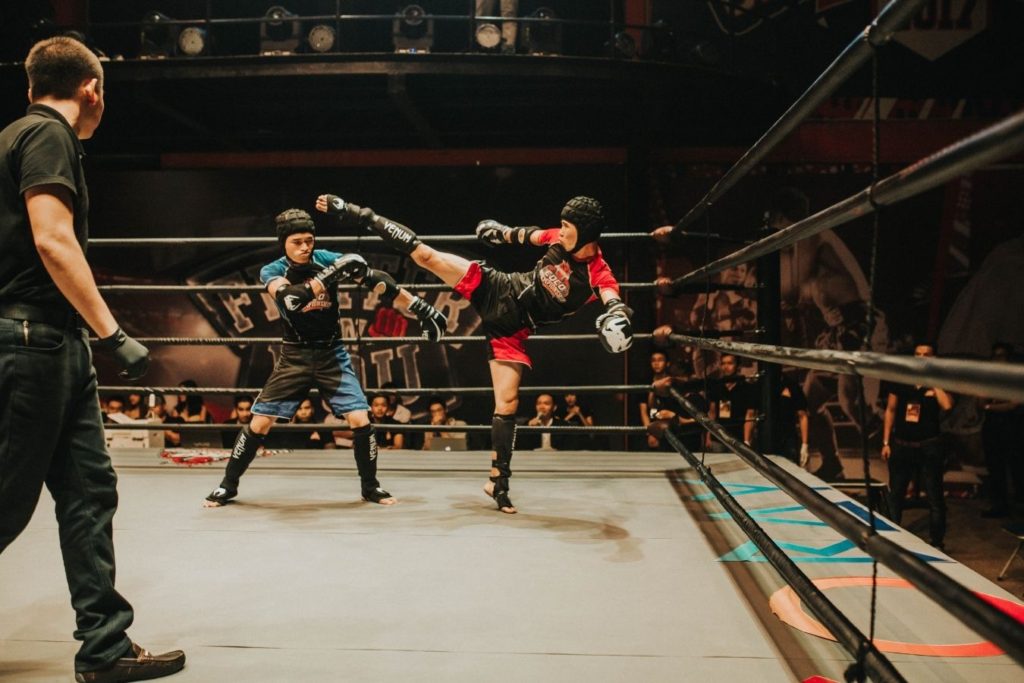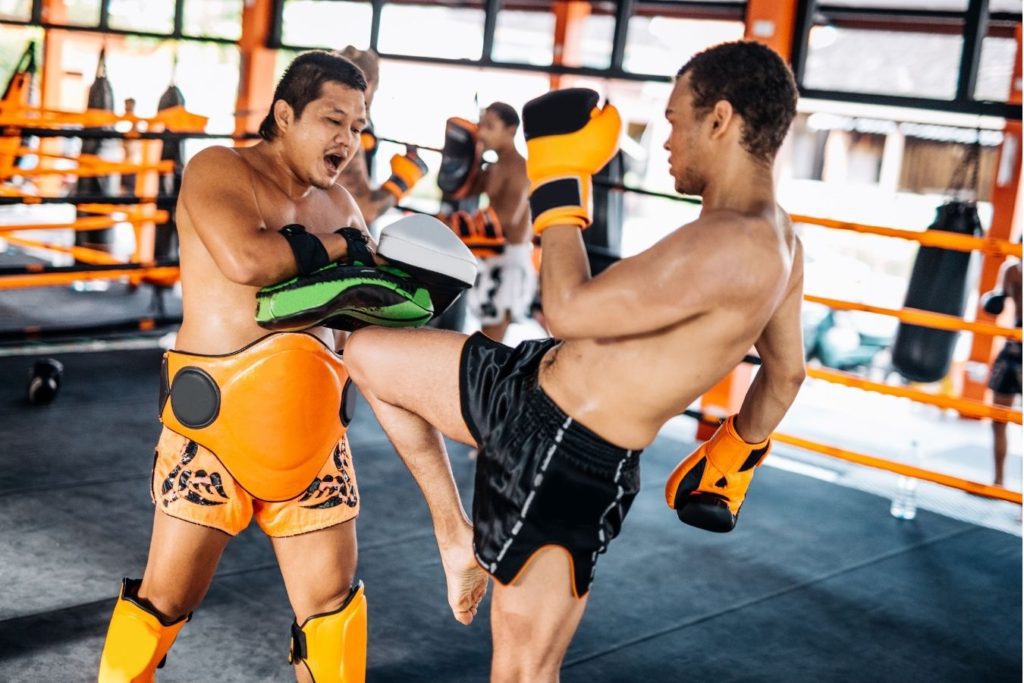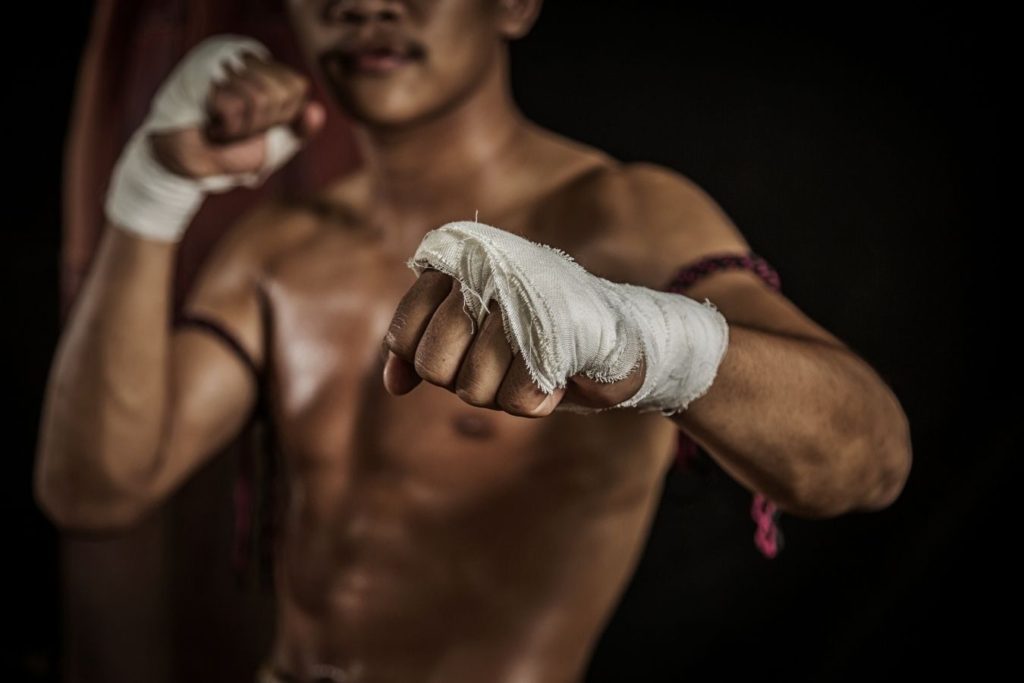Many martial art vs. martial art comparisons showcase vast differences, and we have to imagine and speculate about fight outcomes. But this is not the case when we look at Muay Thai and kickboxing.
The two styles are a lot more similar than different, and the things that set them apart are more subtle technical details than the completely different approaches to fighting we have if we compare boxing to wrestling, for example. Do you know the main differences between Muay Thai and kickboxing?
Both Muay Thai and kickboxing are striking combat sports emphasizing punches and kicks to knock out or outscore an opponent in a match. The main difference is that Muay Thai also allows elbow and knee strikes and extensive clinching, and fights are slower-paced, while kickboxing is more dynamic.
The two styles are hugely popular both in terms of viewers and practitioners, and it is worth knowing the details regardless of whether you are simply a spectator of combat sports or want to feel the thrill yourself and wonder what school to enroll in.
What Is Muay Thai
Muay Thai, often called the Art of eight limbs, is the national sport of Thailand and a martial art with ancient roots. The modern sport is a striking discipline emphasizing heavy kicks, knees, elbows, and clinching.
Discover The Little Known Secrets For Unlocking Devastating KO Power!
Heavy hands are built doing these things...
The history of Muay Thai can be traced back to at least the 14th century when warriors from the kingdom used unarmed fighting techniques on the battlefield.
As time progressed, the art devolved and began to be used for entertainment and as part of ceremonies and festivals.
By the turn of the 20th century, Muay Boran, the predecessor of Muay Thai, had already been formalized.
In the 1920s, the rules were codified and included using a square ring, padded boxing gloves, and other details adopted from Western boxing. The name was also changed to Muay Thai to reflect the many changes to the earlier style.
In the 1980s and 1990s, Muay Thai was hugely popular in Thailand and the area, but its worldwide popularity came thanks to kickboxing and MMA.
Thai fighters started competing and winning in K-1, while Muay Thai stylists from Brazil succeeded in MMA, which exposed large audiences to Muay Thai. The style became hugely popular as an individual sport and a base for mixed martial arts.
What Is Kickboxing
Kickboxing encompasses many striking styles that use punches and kicks, but today, the word is mainly used to describe a specific combat sport. Kickboxing is a fast-paced, full-contact striking sport that allows punches, kicks, and knees.
Kickboxing was developed in the 1950s by Japanese karatekas who adapted boxing and Muay Thai techniques into karate and came up with the term kickboxing.
Two distinct versions began developing in the Netherlands, brought in by Jan Plas after he was introduced to the style by Kenj Kurosaki and in America.
The Dutch-style kickboxing took more influences from boxing and focused more on punching, while the American variation was more karate-like, utilizing a more bladed stance and side kicks.
While the three branches—Japanese, Dutch, and American—were developing independently from each other, all of them had clashes with Mua Thai, which heavily influenced them.
The birth and boom of the sport of kickboxing was the creation of the K-1 promotion in the early 1990s. The best kickboxers of different styles battled for supremacy for over a decade.
The ruleset became the main form of kickboxing, was adopted, and is still used in the top kickboxing organizations like Glory, One FC, Rise, and many others.
Key Differences Between Kickboxing and Muay Thai

It’s worth noting that each fighter, be it a Nak Muay or a kickboxer, has individual traits that break the mold.
Kickboxers can come from various styles, and a Dutch kickboxer like Nicky Holzken will fight in a different way than a Japanese one like Takeru, who will fight differently than a karateka like Raymond Daniels and so on.
In the same way, Muay Thai has a lot of tropes ingrained in people’s minds, but not all fighters fight the same.
There are different stylists, like Muay Femur technicians like Saenchai, Muay Mat punchers like Rodtang, and insane Muay Tae kickers like Buakaw and Yodsanklai, to name a few.
Nevertheless, we can still use the many repeating aspects to draw meaningful conclusions for most fighters from each style.
Rules
Kickboxing has a few sets of different rules. American-style kickboxing did not allow low kicks, and amateur tournaments still hold fights under this ruleset. Other rulesets, both amateur and professional, can ban knees.
But the most popular ruleset used in all elite pro-level organizations is the so-called K-1 ruleset, so we will use that in the comparison.
One of the critical differences between Muay Thai and kickboxing is the number of weapons fighters have at their disposal.
In Muay Thai, you can use eight “limbs”—punches, kicks, elbows, and knees—while elbows are not allowed in kickboxing.
When the fight moves into close range, things also differ. In Muay Thai, clinching is allowed, and strikes, sweeps, and throws executed from the clinch are highly scored.
The idea of kickboxing is to be an action-packed, fast-paced, striking affair, and clinching is very limited, to the point that in places like Japan, it is separated the second it happens.
Still, officially, fighters are allowed to clinch for a couple of seconds and throw a knee without pulling the opponent.
Muay Thai matches are 5 rounds, while most kickboxing fights are 3 rounds long, with only championship fights being 5 rounds.
Techniques
The two styles use many shared techniques, but besides the obvious things like the presence of elbows, clinching, sweeps, and trips in Muay Thai, there are other more subtle differences even in the common techniques.
Muay Thai has a couple of trademark kicks: the teep and the roundhouse. The teep is a front kick, also called the push kick.
The primary goal of the lead teep is to keep the opponent at a distance and prevent them from advancing, while the rear teep is used to knock the opponent back, ideally to put them on the canvas.
Thai-style roundhouse kicks are extremely powerful, thrown with a wind-up, and delivered with a full hip rotation. The ideal landing area is the lower to mid-shin. This style of kicking resembles hitting someone with a baseball bat.
Kickboxing, a hybrid style with different influences, has more variety in the techniques. Punches come from Western boxing and are usually a lot more educated than those used by Thai boxers.
Kicks can vary from Thai style to full-on karate snappy style foot kicks. But for most kickboxers, the kicking style is somewhere in between karate and Thai style.
Some fighters also use more exotic techniques like axe kicks, side kicks, spinning heel kicks, and others.
Stance
The fighting stance of both styles reflects the dynamics of the fight. But before we get to the pace, let me explain the characteristics and stances.
The typical Muay Thai stance is heavily squared, meaning the hips are facing forward. The weight is more on the back foot, while the lead remains light.
Both hands are high and slightly outstretched ahead, although many fighters keep both fists close to their heads.
Most kickboxers will have a slightly bladed stance, less square than in Muay Thai, but not entirely sideways. The hands are high, with the lead hand slightly stretched forward and the rear close to the head.
Footwork and Dynamics
Footwork and the overall dynamics of a fight are two of the most significant differences someone more experienced in watching fights will notice.
Muay Thai footwork is more “basic” because fighters move around much less. This doesn’t mean they don’t expertly judge distance; it’s just that they do it with fewer movements and fewer angles.
Thai judges do not view going backward favorably, which is a big reason fighters do not move as much and usually block strikes instead of moving out of the way.
On the other hand, kickboxing looks more like boxing in the way footwork is used. Many fighters like to dart in and out of range, open up and make angles, and use a lot of head movement. They are generally lighter and bouncier on their feet.
Kickboxers rely more on fast punching and kicking combinations, while Thai fighters use more single strikes.
The overall pace of kickboxing is almost always higher, firstly because there are fewer rounds and secondly because of the scoring.
In kickboxing, each round is scored individually and equally, whereas in Muay Thai fights, the third and fourth rounds hold much more significance in the eyes of the judges.
Competitive Landscape
Both Muay Thai and kickboxing have very well-developed competitive circuits. Being a national sport with immense cultural significance, Muay Thai is still at its strongest in its home of Thailand. There are many dedicated stadiums, and the entire country enjoys the sport.
Internationally, some organizations hold high-level professional events, with the main one currently being One FC, but the stars are still mostly Thai fighters, with a few key exceptions.
Kickboxing has a more widespread competition circuit. First, the sport has a solid amateur competition scene in Europe, whereas Muay Thai is much smaller as an amateur sport.
Professionally, Glory and One FC hold the biggest international events, but some countries like the Netherlands and Japan (the places where kickboxing originates) also have very strong domestic leagues.
Equipment
The equipment for Muay Thai and kickboxing is almost the same. Some apparel differences exist, but in terms of equipment, you will need the same set to train in both styles, and it includes:
- Muay Thai gloves OR Kickboxing gloves
- Muay Thai shin guards
- Mouth guard
- Groin guard
- Headgear
Muay Thai vs Kickboxing For MMA
Because both styles are full-contact striking sports, they are excellent for MMA. On paper, Muay Thai should have the upper hand because it has more tools like elbows and clinch fighting, but I believe they are equal regarding MMA effectiveness.
In the end, both need modifications to work. Muay Thai does have more weapons, but the stance and overall dynamics of fights are less suitable for MMA, where the threat of a takedown is always looming. Kickboxers have better punching and better footwork, which are great for MMA.
Given the number of elite MMA fighters coming from both styles, it’s safe to say they both are great bases for developing a complete MMA skillset.
Muay Thai vs Kickboxing For Self-Defense

The comparison for self-defense practicality is also very even. Muay Thai has a slight advantage, mainly because of the clinching game, which can be invaluable in many real-life situations. Aside from this, the strong areas of the two styles largely overlap.
Both kickboxers and Muay Thai practitioners are great strikers, accustomed to delivering and receiving full-power strikes, and more than capable of handling most people you can get into altercations with.
The more subtle tactical and technical differences between the two styles are important in a combat sports scenario where fights last multiple rounds and are between equally trained people.
On the street, fights usually end much quicker, and finer details like stance width, strike preferences, and tempo lose significance.
A Muay Thai fighter and a kickboxer are more than capable of knocking someone out in seconds.
The apparent downside of both for self-defense is ground fighting, where they are equally unprepared.
Muay Thai vs Kickboxing: Who Would Win?

Muay Thai and kickboxing have been battling it out in rings worldwide since the first day of kickboxing. In fact, fights between Japanese karatekas and Muay Thai fighters in the 1960s were largely the spark that created kickboxing.
American and Dutch kickboxing were exported from Japan, but Dutch kickboxers had much more success against Thais.
Low kicks were not allowed in America until a fateful match between Changpuek Kiatsongrit and Rick Roufus proved Muay Thai was the superior style and changed the history of combat sports in America.
Generally, Thai fighters win under Muay Thai rules, while kickboxers are better under kickboxing rules, which is hardly surprising. But the exciting part is that this is only sometimes the case, and due to this, we’ve had some incredible fights over the years and continue to do so.
In the glory days of K-1 MAX, there were many epic clashes between Thai fighters, Dutch kickboxers, and Japanese kickboxers, each with distinct stylistic differences.
The winner was never predetermined, and each style produced notable champions.
So unlike other comparisons where one style is usually the clear winner, in the battle between kickboxing and Muay Thai, everything is determined by the personal qualities of the fighters.

